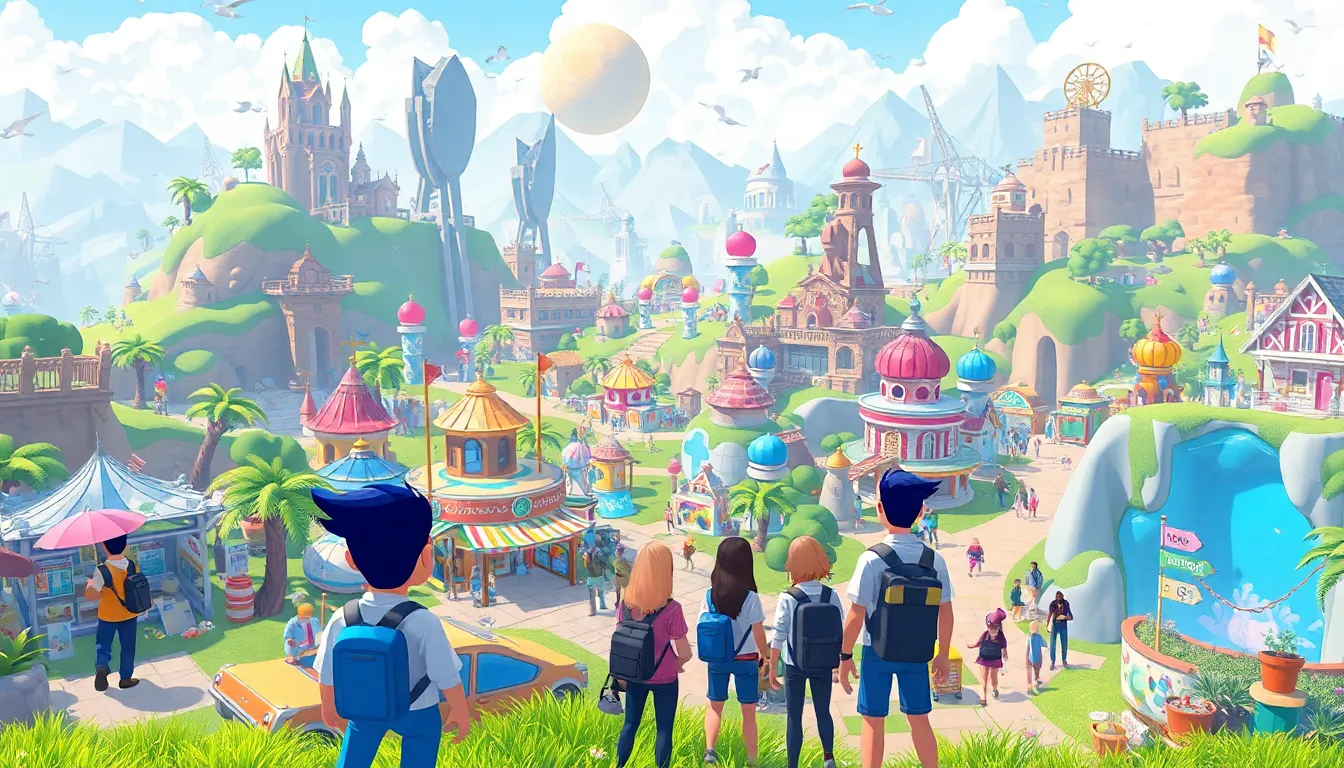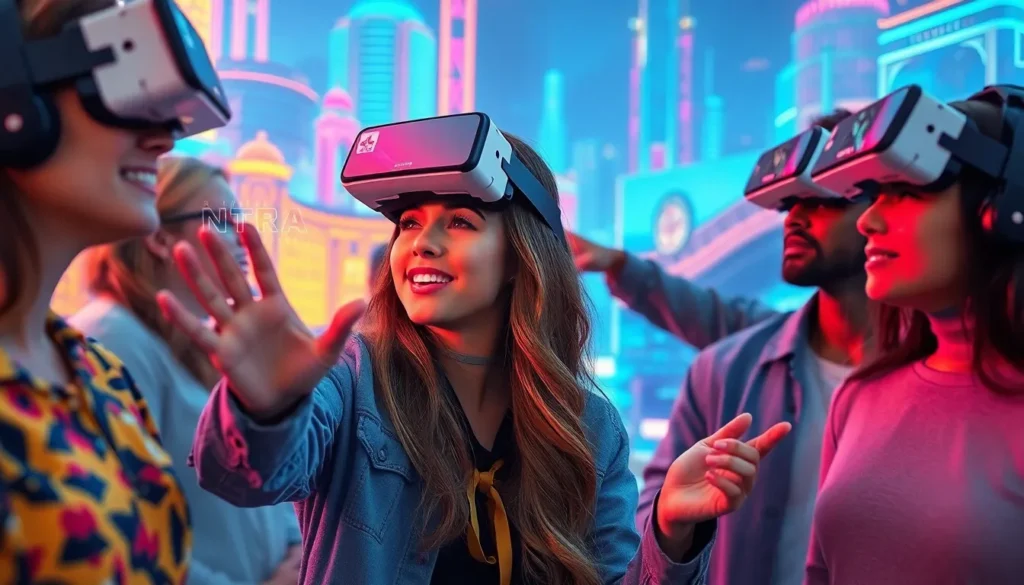Welcome to the wild world of the metaverse, where virtual reality meets digital ownership in a way that’s more exciting than a cat meme on a Monday morning. NFTs, or non-fungible tokens, are shaking things up, turning pixels into prized possessions. Imagine owning a piece of digital art or a virtual plot of land that’s as unique as your grandma’s secret cookie recipe.
Metaverse NFT
The metaverse combines virtual reality with digital ownership. This digital space revolutionizes how individuals interact with digital assets through NFTs.
Definition of Metaverse
The metaverse refers to an expansive digital universe where users can engage, create, and transact. It encompasses various virtual environments, offering immersive experiences for activities like gaming, socializing, and business. Popular platforms include Decentraland and The Sandbox, allowing users to build unique experiences within a shared, interconnected ecosystem. This universe represents a convergence of technology and creativity, enabling individuals to explore and shape their digital identities.
Understanding NFTs
NFTs, or non-fungible tokens, represent unique digital assets verified on a blockchain. Each NFT carries distinct metadata that sets it apart from other tokens. Digital art, music, and virtual real estate often utilize NFTs to ensure originality. Ownership of these tokens provides proof of authenticity and provenance, appealing to collectors and investors. Platforms like OpenSea and Rarible facilitate the buying and selling of NFTs, contributing to a growing marketplace that enhances the value of digital possessions.
The Rise of Metaverse NFT

Metaverse NFTs are gaining significant traction. Interest in digital ownership has surged, reflecting broader trends in technology and culture.
Popularity and Trends
NFTs in the metaverse are becoming mainstream. The growth of virtual worlds has increased demand for digital assets. In 2021 alone, the NFT market reached nearly $41 billion, showcasing its rapid expansion. Gaming platforms facilitate user engagement through virtual goods, while artists profit from unique creations. Primary appeal comes from the exclusivity NFTs provide, allowing collectors to showcase distinct ownership. Social media campaigns have further amplified awareness, attracting new users and investors into the marketplace.
Key Platforms for Metaverse NFTs
Several platforms dominate the metaverse NFT landscape. Decentraland enables users to purchase virtual land and develop experiences, while The Sandbox offers robust tools for creating and monetizing content. OpenSea stands out as a leading marketplace for buying, selling, and trading NFTs across various categories. Rarible, another prominent auction platform, prioritizes community involvement, allowing users to govern and influence decisions. Each platform plays a crucial role in shaping the metaverse economy, driving collaboration and innovation among creators and users alike.
Benefits of Metaverse NFTs
Metaverse NFTs offer distinct advantages tied to ownership, authenticity, and creativity. Their unique characteristics transform the digital landscape significantly.
Ownership and Authenticity
Ownership in the metaverse is secured through NFTs, ensuring users possess genuine digital assets. Each NFT, verified on the blockchain, carries distinct metadata that guarantees originality and provenance. This authenticity engenders trust among collectors and investors. Artists benefit from owning their works distinctly, limiting unauthorized reproductions. Additionally, virtual real estate investors can assert ownership of their properties, with clear records confirming their titles. This definitive ownership fosters a transparent marketplace, allowing buyers and sellers to engage confidently.
Creative Opportunities for Users
Creative opportunities within the metaverse expand significantly due to NFTs. Users may develop unique virtual experiences, ranging from digital art to interactive environments. Artists can monetize their creations directly and retain control over their work. Gamers enjoy vast customization options, creating personalized avatars and immersive worlds. Collaborative projects thrive as individuals team up to build shared metaverse experiences. Platforms like Decentraland and The Sandbox empower creators to explore their visions, enhancing user engagement. Consequently, innovation flourishes as new ideas emerge within this inclusive ecosystem.
Challenges and Concerns
As the metaverse and NFTs continue to evolve, several challenges and concerns emerge that could impact their growth and acceptance.
Environmental Impact
Developing the metaverse relies heavily on blockchain technology, which often involves significant energy consumption. Mining cryptocurrencies for NFT transactions generates a substantial carbon footprint. Some estimates suggest that a single Ethereum transaction can use as much energy as an average household in a week. Users are growing increasingly concerned about this environmental toll. Transitioning to more energy-efficient systems, like proof-of-stake, shows promising solutions. Several platforms are exploring ways to reduce their ecological impact, emphasizing sustainability alongside innovation.
Market Volatility and Speculation
Market volatility shapes the perception of NFTs and the metaverse. Prices often fluctuate dramatically, which can deter potential investors. In 2021, the NFT market saw valuations soar before experiencing sharp corrections. Speculation drives demand, which leads to price bubbles that can burst rapidly. Following these fluctuations, many participants face significant financial risks. Awareness of these dynamics is crucial for users engaging in purchases. Investing prudently, supported by research and understanding market trends, is essential for navigating this unpredictable landscape.
Future of Metaverse NFTs
The future of metaverse NFTs promises exciting developments and transformative influences across digital landscapes. As technology evolves, so do the opportunities for innovation.
Predictions and Innovations
Growth in the metaverse NFT market suggests an increase in diverse use cases. Artists can leverage NFTs to create unique experiences, integrating augmented reality and virtual elements into their artwork. Ownership models may also evolve, allowing fractional ownership of high-value digital assets, thus broadening accessibility. Social interactions are expected to deepen, with NFTs serving as social status symbols within virtual communities. Enhanced interoperability is likely as platforms strive to allow users to transfer assets seamlessly across different virtual environments.
Potential Integration with Other Technologies
Integrating metaverse NFTs with artificial intelligence could bring personalized experiences tailored to user preferences. Data-driven insights may enhance engagements, helping creators design bespoke content. Blockchain technology’s evolution might also foster cross-chain compatibility, enabling users to transact with NFTs across various networks with ease. Furthermore, developments in 5G networks may improve the metaverse experience by providing faster connections and reducing latency. Ultimately, these technological advancements are set to elevate the functionality and allure of metaverse NFTs significantly.
Conclusion
The metaverse and NFTs are reshaping the digital landscape in profound ways. As users navigate this expansive universe they’re discovering new opportunities for ownership and creativity. The growing interest in metaverse NFTs signals a shift in how people perceive value in digital assets.
While challenges like environmental concerns and market volatility persist the potential for innovation remains strong. Future developments could redefine ownership models and enhance user experiences. As technology evolves so will the ways individuals engage with and invest in the metaverse. This dynamic ecosystem is poised to become a cornerstone of digital interaction in the years to come.

